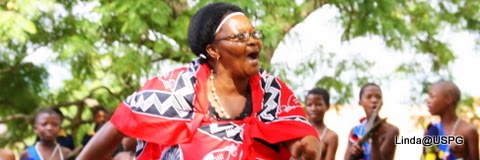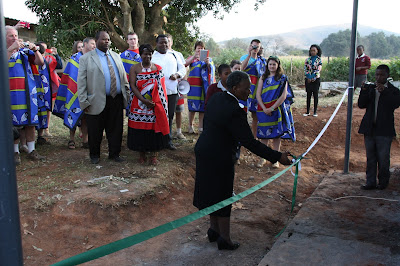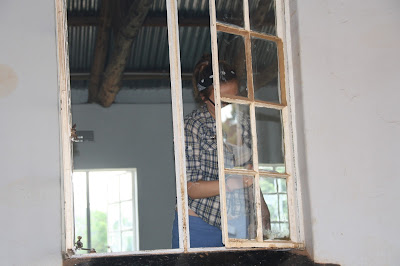Sunday 20 October 2013
Monday 16 September 2013
Reilly's Rock, Mlilwane Game Reserve: we had to shoot the patient.
One of the people who know first-hand the history of big game parks in Swaziland is Ted Reilly, the MD of Big Game Parks in Swaziland. I spoke to him on the veranda of the house in which he grew up, which is now called Reilly’s Rock in the Mlilwane Game Reserve. Ted’s father, Mickey turned the family farm into the first game reserve in Swaziland and the family have since established another three parks. Ted told me that his father came to Swaziland with the British troops for the Anglo Boer War. He was member of the Steinacker’s Horse and was with them when they took Bremmersdorp (now Manzini) from the Boers. After the war he decided to stay on and lived at Mlilwane where he started mining tin. When WW1 broke out he was not allowed to join because his mining was considered essential to the war effort. His contribution was to build a RAF base on a ridge near Mlilwane where Spitfires and Hurricanes regularly took off and landed. Mickey told his son how it took them 3 to 4 days on horseback to travel to Johannesburg. With the arrival of cars that trip could take up to 10 days depending on how long they had to wait for swollen rivers before a safe crossing. There were also numerous concertina gates to be opened and closed on this trip. Mickey Reilly also brought the first electricity to Swaziland. It was generated by a 52,5KVA alternating hydro power plant for the purpose of separating tin from iron at his tin mine.
Reilly’s Rock in the Mlilwane Game Reserve
A man named Moolman in 1919 built the house in which Ted grew up and it took him several years to build it. Moolman offered to build the house in exchange for an ox wagon, which cost about 80 pounds in those days. That house and interior has changed very little in the last 50 years. It is an original “Out of Africa” house and has offered hospitality to many well-known personalities in the conservation arena. People like Prince Bernard, Dr. Ian Player, Dr Anton Rupert to name but a few. (When you visit Mlilwane this house is available for accommodation and not too expensive if you are paying in sterling/euro.)
“We had to shoot the patient…”
Ted Reilly has many tales to tell about his experiences with the wild life in Swaziland. He was brought up among wild animals and as an adult he returned to Mlilwane to help establish the games reserves. One can imagine that Ted Reilly and his staff had a lot to learn and they did most of by trial and error.
One of Ted’s stories that I just love to repeat is about a kudu that had a broken leg. In those early years a kudu was a precious animal. Ted says that against his better judgement but spurred on by a friend, a newly qualified surgeon Dr. John Fleming they decided to catch the kudu and amputate his leg. They caught the kudu but the doctor did not have the right equipment for the operation so they drove to the Mbabane hospital. Ted says: “We arrived there in the early hours of the morning and knocked up the night nurse, who, when she saw the roughest looking group of dirty unshaven guys clad in greatcoats stained with kudu blood, nearly had a fit. John Doctor – as we called him- took over, he was very authoritative and introduced himself as a doctor with a crisis on his hands. He explained he had a patient who needed an emergency operation and asked to be shown the instrument cupboard. The confused nurse did not argue and John chose his instruments, with a promise of a quick return the group marched out leaving a bewildered nurse gaping in the doorway. We left the vehicle with the kudu a little way off because there was doubt that the hospital staff would facilitate an operation on an animal with their instruments.” The amputation was done but the kudu had lost too much blood and it had weakened and they all realised it was a futile attempt and that the kindest thing would be to end the kudu’s suffering with a bullet through the brain. “The cocks were crowing their 4 o’clock signals when we returned the instruments to the hospital. John handed them over to the nurse with firm instructions to sterilise them properly. The nurse then hesitantly asked about the patient and John replied sadly” It did not work out, I’m afraid she was too far gone so we had to shoot her.” The nurse showed signs of fainting and John helped her to a chair where we left her in a state of shock.”
Tuesday 3 September 2013
Independence Day in Swaziland
Independence Day 6 September
Once upon a time there was a powerful nation that went around the world and colonized many countries. One of these countries that became a British protectorate in 1903 was Swaziland. The Nguni people have always been governed by a monarch. The previous king, Sobhuza II, ruled this nation from 1921 till his death in 1982, as paramount chief and later as the internationally recognised king. The British governed the territory until 1967 when it once again became a self-governing state, flying its own flag.
The symbolism of the flag: The red stands for past battles, the blue for peace and stability, and the yellow for the resources of Swaziland. The central focus of the flag is a shield and two spears, symbolizing protection from the country's enemies. Its colour is meant to show that white and black people live in peaceful coexistence in Swaziland. The flag is based on one given by King Sobhuza II to the Swazi Pioneer Corps in 1941. On it is an Emasotsha shield, laid horizontally. The shield is reinforced by a staff from which hangs injobo tassels-bunches of feathers of the widowbird and the lourie. They also decorate the shield. Above the staff are two assegais-local spears
Independence Day is celebrated in different ways in the country, with a public holiday and many festivities. Below is an article from a publication of the International Trade Union Confederation showing what those not living in Swaziland think:
African Unions Lead Global Protests on Swaziland Independence Day
6 September 2012: African trade unions and other civil society organisations have led international protests against Swaziland’s rulers on 6 September, the country’s independence day.
A 5 September picket in front of the Swazi consulate in Johannesburg was joined by 18 union leaders from across the continent, including Kwasi Adu-Amankwah, General Secretary of ITUC-Africa. National solidarity actions also took place in Kenya, Nigeria, Senegal, Togo, Belgium, Germany and the UK.
The protests are part of a week of action on Swaziland, in response to the continuing suppression of the democracy movement there, including the banned national trade union centre TUCOSWA. Peaceful marches inside the country this week have been met with violent repression and arrests.
Swaziland is one of the last absolute monarchies in the world. About 60% of its population gets by on less than 1.25 USD per day, while King Mswati sends his family members shopping in Germany with his private jet. The country’s economy is in tatters after almost forty years of “Tinkhundla” rule, after a state of emergency was established in 1973, giving the monarchy almost unlimited power. Political parties are banned, there is no press freedom or independent judiciary, and the king himself appoints the government.
Tuesday 27 August 2013
The Reed Dance - Umhlanga
In late August, early September all over the Kingdom one notices groups of girls gathering or moving on foot with male supervisors dressed in traditional attire. The girls will be dressed in their normal everyday clothes and carrying bags with some provisions and their traditional outfits in. As the week progresses the groups get bigger, they start moving towards the Ezulwini valley, and the police become involved to regulate the traffic and ensure everyone’s safety.
Towards the end of the week more girls start exchanging their everyday clothes for their traditional attire. The atmosphere around these groups is that of festivity, lots of singing and sometimes dancing.
This is an age old tradition that still takes place every year. Maidens from all over the Kingdom gather at designated areas to cut reeds to replace the reeds at the Queen Mother’s home. Girls of all ages, but mostly in their teens, take part in this festive event. In the past they used to carry the cut reeds with them on their journey to the Ndlovukazi’s (the Queen Mother) homestead but today the reeds are loaded onto trucks.
The day of the reed dance, also known as Umhlanga, starts with the maidens bathing and grooming. Then they all dress in their traditional dress. The traditional dress the girls wear includes very short beaded skirts with necklaces, sashes, bracelets and ankle bracelets. The girls from the Royal household wear red feathers in their hair.
The procession into the stadium where the event takes place is led by the princesses of the Royal Family. The groups of maidens from the various chiefdoms each perform their own dances and songs. One of the purposes of this event is to nurture the unity of the clans or chiefdoms of the Swazi nation.
I have spoken to some younger Swazi women who are also mothers. They have told me that they will not allow their daughters to take part in this event as it is old fashioned and, they think, degrading to the young girls. But when you attend this event then it is evident that thousands of young girls think traditional ways are not outmoded yet.
 Just a word of warning if you do plan to attend this event: tourists are welcomed but females must wear skirts or dresses. It is not appropriate for a female to be in the presence of royalty if she is wearing slacks or shorts.
Just a word of warning if you do plan to attend this event: tourists are welcomed but females must wear skirts or dresses. It is not appropriate for a female to be in the presence of royalty if she is wearing slacks or shorts.
Heloise
Sunday 18 August 2013
Saturday 27 July 2013
Sunday 21 July 2013
Week 3
Swaziland, week 3
A weekend off for Bishop Ellinah
Anglican Communion News Service reports that thousands of Christians from Botswana and beyond attended the enthronement and consecration of Botswana’s new and fifth bishop, the Rt Revd Metlhayotlhe Rawlings Beleme, the first Botswana-born bishop of the diocese.The five-hour long service, presided over by the Primate of Central Africa the Most Revd Albert Chama, was held at the Holy Cross Cathedral in Botswana's capital Gaborone. It was described as a “wonderful mix of deep Anglican liturgy and rich Setswana culture.
No reporting of the fact that Bishop Ellinah, who was enthusiastically invited by the Diocese of Botswana, was informed on Thursday last that while she could attend the service she could not vest as a bishop nor sit in the sanctuary with the other (male) bishops.
No reporting of the fact that Bishop Ellinah, who was enthusiastically invited by the Diocese of Botswana, was informed on Thursday last that while she could attend the service she could not vest as a bishop nor sit in the sanctuary with the other (male) bishops.
Bishop Ellinah decided not to make the long journey (7 hours drive each way), so we went out for lunch on Saturday with her grandson, Baraka, and Maureen Moss from Limerick Diocese. We visited the Ngwenya Glass Factory, where beautiful things are made from recycled glass - and the chocolate shop.
The Diocesan Office
I've been spending my days in the Diocesan Office - long days 8am till 5pm. I'm helping Mrs Tembe with her filing, both in cabinets and on her computer.
Beketele Tembe
Mrs Tembe has worked for four bishops of Swaziland, and is now Bishop Ellinah’s PA. She meets the visitors and looks after the diary. I have been helping her clear out some old files - which is a slow job because so many of the files are interesting!
Mr Andreas Zwane, the gardener and care-taker, has been part of the bishop’s household since he was 9 years old. On Monday he brought me a present of a live chicken. Thankfully Bishop Ellinah’s helper, Jabu, dealt with it, and we had it for dinner on Tuesday.
Celebrations at Usuthu Mission
Wednesday was the last day for the Rathfarnham team at Usuthu Mission Anglican Primary School. Staff and pupils were delighted with the seven repainted classrooms, and the progress on a new design of kitchen which will reduce the fuel bill by 70%. After receiving pencil cases donated by Us supporters in Ireland the 550 children had a "holiday" lunch with meat. They then put on a special show for the Irish visitors with sketches and speeches, and modern and traditional dance. Happy, the project manager for the parents' committee, gave us all a Swazi emahiya, and the staff prepared a delicious lunch. Usuthu Mission is the school where Maureen Moss is working. She was one of the staff members who cooked lunch, and then one of the visitors for the show.
Pencil cases from Ireland
The blessing of the kitchen
Newly painted classroom
Saturday in Hlane Game Park
with Mandla and Maureen
Week 2
On Saturday afternoon Jan & Mandla set off in convoy with the bus for Johannesburg OR Tambo Airport. They, and the bus driver, were booked into a B&B nearby - a scary experience for all three. They were at arrivals at 4.30 on Sunday morning to meet the team for the drive to Swaziland.
By 10 am they had crossed the border, and soon afterwards arrived at Thokoza, the Diocesan Centre, where they are staying in a combination of twin rooms and a self-catering bungalow. After breakfast and a rest they set off for Mlilwane Game Park, where they saw various types of antelope, hippos and zebras; no crocodiles out today.
The team attended Holy Communion in St Matthias’ Church, Ezulwini, and then headed for Thokoza for supper and an early night.
Early on Monday morning the Rathfarnham team set off for Usuthu Mission Anglican Primary School. They were there in time for assembly at 7.45am.
The team divided into 3 groups: one group to build a kitchen; one group to paint classrooms; one group to work with pupils and teachers.
On Thursday we drive over two hours to visit Fr Gregory Makhubu. Rector of Hlangano and surrounding areas, Fr Gregory looks after a number of Neighbourhood Care Points in the south-east of Swaziland. There is great poverty here, malnutrition, and high rates of HIV infection. Fr Gregory estimates that 75% of the pre-school children attending this NCP are HIV positive.
The Care Point is run by the Simelane family, who very kindly allowed us to visit their homestead. Mr Simelane grows a small crop of cotton, which he stores in his sleeping hut.
Subscribe to:
Posts (Atom)











.JPG)
.JPG)
.JPG)

.JPG)
.JPG)
.JPG)






































